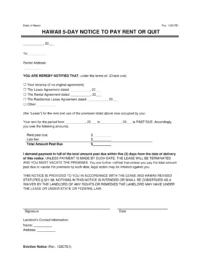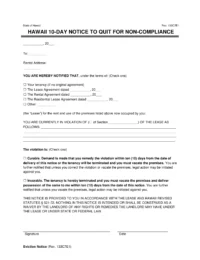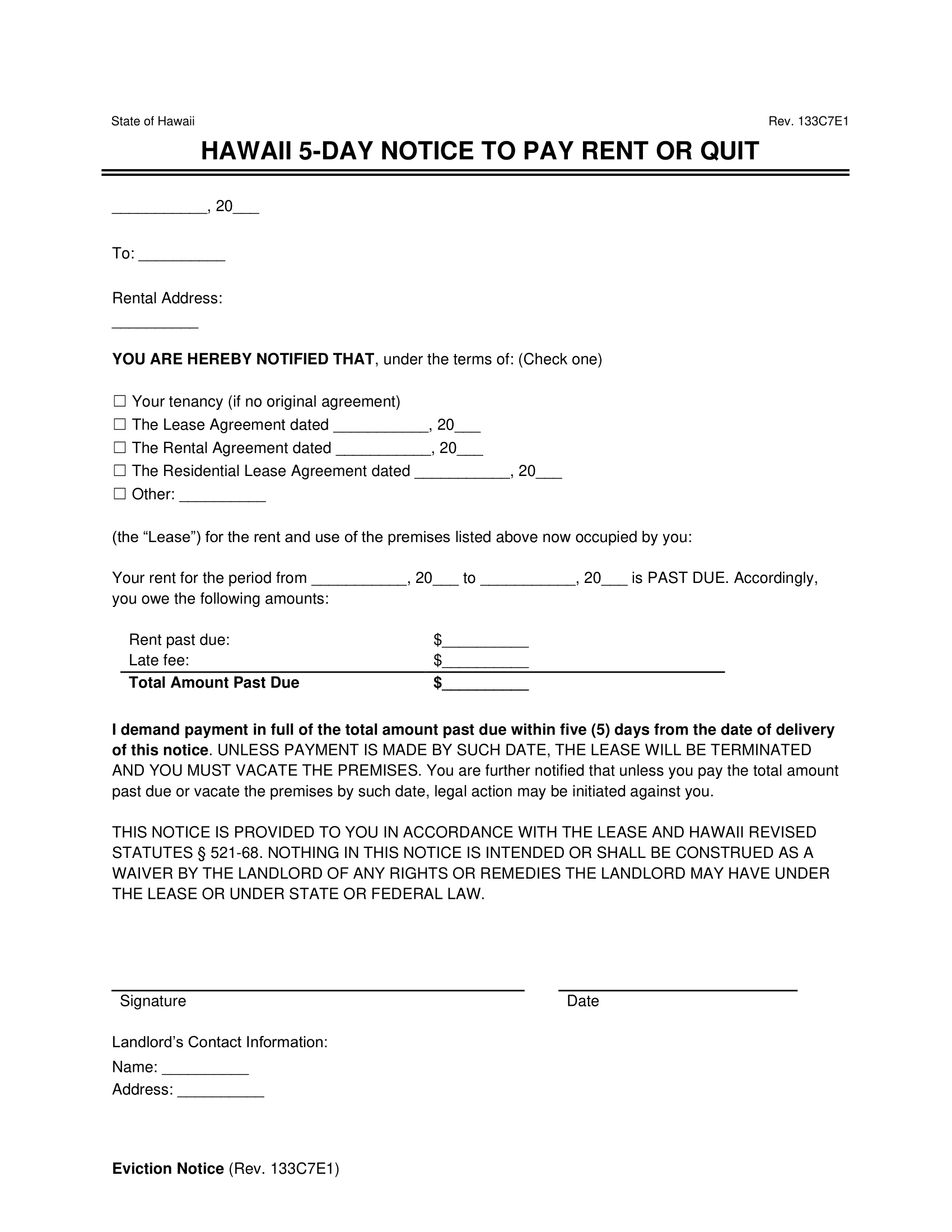Understanding Eviction Notices in Hawaii
Landlords in Hawaii are required to give tenants written notice before initiating an eviction lawsuit. The notice must clearly explain the lease violation or reason for termination and give the tenant a legally mandated period to fix the issue or vacate.
Under the Hawaii Residential Landlord-Tenant Code (Chapter 521), notice periods vary based on the reason for eviction: 5 days for unpaid rent, 10 days for lease breaches, and 45 days to end a month-to-month agreement.
Using Legal Templates’ document builder, you can create a Hawaii eviction notice tailored to your situation and compliant with local law in just minutes.
Types of Eviction Notices in Hawaii
Hawaii law requires landlords to issue specific eviction notices depending on the reason for ending the tenancy. Each type of notice has a legally defined timeframe and must be properly served before filing an eviction case in court.
5-Day Notice to Pay Rent or Quit
If a tenant fails to pay rent on time, Hawaii law (HI Rev. Stat. § 521-68) requires landlords to serve a 5-day notice to pay or quit. This gives the tenant 5 calendar days to pay the overdue rent or move out before the landlord can file for eviction.
5-Day Notice to Pay Rent or Quit
Begin evicting a tenant if they haven’t paid rent on time.
10-Day Notice to Quit for Non-Compliance
For other lease violations — such as property damage, unauthorized occupants, or other breaches — landlords must issue a 10-day notice to cure or quit under HI Rev. Stat. § 521-72. This gives tenants 10 days to correct the issue or face legal eviction.
10-Day Notice to Quit for Non-Compliance
Give tenants ten days to fix (or “cure”) the problem before eviction can proceed in court.
45-Day Lease Termination Letter (Month-to-Month Tenancy)
To end a month-to-month tenancy without cause, landlords must provide a 45-day written notice, per HI Rev. Stat. § 521-71. This applies when neither party has violated the lease but the landlord wants to end the rental agreement.
45-Day Lease Termination
Inform the tenants to move out if they’re on a month-to-month lease.
How to Evict a Tenant in Hawaii
Evictions in Hawaii follow the procedures outlined in Chapter 521 of the Hawaii Revised Statutes. Here’s a step-by-step breakdown of the legal process:
Step 1: Landlord Provides Written Notice
Before the eviction process begins, a landlord may want to give their tenant a late rent notice, which encourages them to correct their rental agreement violation. If this doesn’t workHere’slandlord may have to evict their tenant(s).
Landlords must provide the tenant with the correct eviction notice type. At this step, it’s possible that the tenant and landlord will agree on the tenant moving out, in which case they can skip the last steps and use a lease termination letter.
Step 2: Landlord Files Complaint
If the tenant fails to correct their violation or respond to the eviction notice, the landlord may file a summons and complaint with the district court in their county. The filing fee is $155.00, and the landlord must include a copy of the lease and eviction notice that they served the tenant.
Step 3: The Summons and Complaint Are Served
A process server licensed in Hawaii must deliver the summons and complaint to the tenant. The tenant has 5 days after receiving the summons to respond.
Step 4: Writ of Possession Issued
If the tenant doesn’t respond, the court issues a ‘writ of possession.’ This allows the landlord to have a police officer remove the tenant and their possessions from the property.
Related Hawaii Court Forms
- Complaint: This form is filed with the district court and legally served on the tenant to inform them of the reason(s) they’re being sued for eviction.
- Summons: This form notifies the tenant of the eviction process in Hawaii, the time and date of the hearing, and the consequences of not responding to the notification.
- Writ of Possession: If the court rules in favor of the landlord, this form gives law officers the power to physically remove the tenant and their possessions from the landlord’s property.








